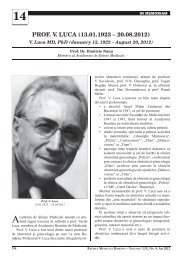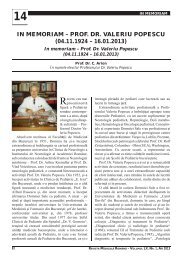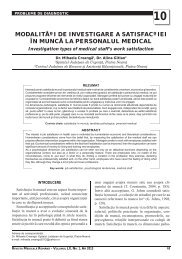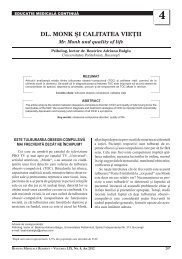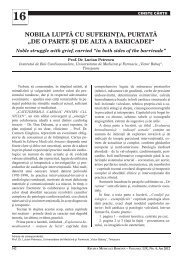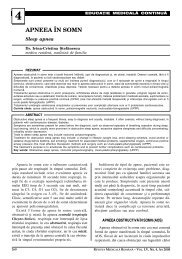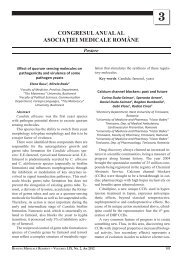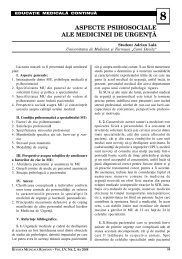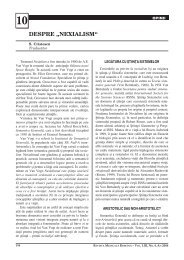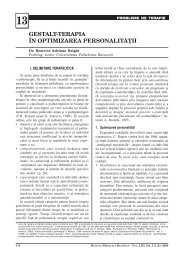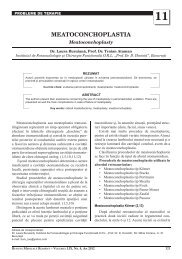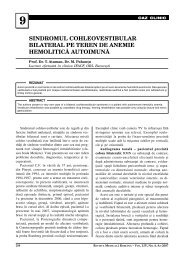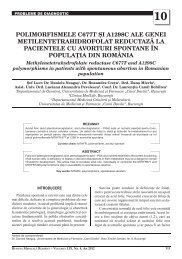tratamentul chirurgical al atreziei de esofag în spitalul clinic de ...
tratamentul chirurgical al atreziei de esofag în spitalul clinic de ...
tratamentul chirurgical al atreziei de esofag în spitalul clinic de ...
Create successful ePaper yourself
Turn your PDF publications into a flip-book with our unique Google optimized e-Paper software.
158<br />
4<br />
EDUCAŢIE MEDICALĂ CONTINUĂ<br />
TRATAMENTUL CHIRURGICAL AL ATREZIEI DE<br />
ESOFAG ÎN SPITALUL CLINIC DE URGENºÅ<br />
PENTRU COPII „GRIGORE ALEXANDRESCU“<br />
Surgic<strong>al</strong> treatment of esophage<strong>al</strong> atresia in the Emergency Hospit<strong>al</strong><br />
for Children “Grigore Alexandrescu”<br />
Dr. Felix Negoi¡escu, Dr. Maria Tucå<br />
Spit<strong>al</strong>ul Clinic <strong>de</strong> Urgen¡å pentru Copii „Grigore Alexandrescu“, Bucure¿ti<br />
REZUMAT<br />
Introducere: Atrezia <strong>esofag</strong>iană reprezintă una dintre afecţiunile importante <strong>în</strong> cadrul chirurgiei neo-nat<strong>al</strong>e,<br />
<strong>tratamentul</strong> său suferind progrese majore <strong>de</strong>-a lungul timpului. În sistemul sanitar românesc <strong>tratamentul</strong> AE<br />
este <strong>în</strong>că difi cil <strong>de</strong> re<strong>al</strong>izat la un nivel occi<strong>de</strong>nt<strong>al</strong>.<br />
Materi<strong>al</strong> şi metodă: Studiul este o cercetare retrospectivă a pacienţilor cu diagnosticul <strong>de</strong> atrezie <strong>esofag</strong>iană<br />
trataţi <strong>în</strong> <strong>clinic</strong>ă <strong>de</strong> Cirurgie Pediatrică Spit<strong>al</strong>ului Clinic <strong>de</strong> Urgenţă pentru Copii „Grigore Alexandrescu“ <strong>în</strong><br />
perioada 2001-2009. Evi<strong>de</strong>nţele primare (registrele operatorii, foile <strong>de</strong> observaţie <strong>clinic</strong>ă) au stat la baza<br />
an<strong>al</strong>izei şi interpretării datelor.<br />
Rezultate: Studiul evi<strong>de</strong>nţiază o reducere semnifi cativă a ratei mort<strong>al</strong>ităţii <strong>în</strong> ultimii 5 ani, chiar dacă numărul<br />
efectiv <strong>al</strong> cazurilor <strong>de</strong> AE aproape s-a dublat. O importanţă majoră pentru supravieţuire o reprezintă greutatea<br />
la naştere mai mare <strong>de</strong> 2500 g. Re<strong>al</strong>izarea <strong>de</strong> <strong>esofag</strong>ostomă şi gastrostomă creşte rata <strong>de</strong> supravieţuire a<br />
celor cu greutate mică.<br />
Discuţii şi concluzii: Închi<strong>de</strong>rea primară a fi stule traheo-<strong>esofag</strong>iene (FTE) concomitent cu <strong>esofag</strong>ostomie şi<br />
gastrostomie, urmată la circa un an şi jumătate <strong>de</strong> <strong>esofag</strong>oplastie cu colon asigură cea mai bună supravieţuire.<br />
Acest proce<strong>de</strong>u este practicat cu totul excepţion<strong>al</strong> <strong>în</strong> occi<strong>de</strong>nt dar se pare că nivelul actu<strong>al</strong> <strong>al</strong> medicinei din<br />
România impune această tehnică la noi <strong>în</strong> ţară, cu toate că este foarte mare consumatoare <strong>de</strong> resurse<br />
umane şi materi<strong>al</strong>e.<br />
Cuvinte cheie: atrezie <strong>esofag</strong>iană, <strong>esofag</strong>ostomie, gastrostomie<br />
ABSTRACT<br />
Background: The esophage<strong>al</strong> atresia is one of the diseases commonly encocuntered <strong>în</strong> neonat<strong>al</strong> surgery,<br />
its treatment registering major progress over time. The treatment of esophage<strong>al</strong> atresia is still diffi cult to be<br />
done at a Western level, due to the Romanian he<strong>al</strong>thcare system.<br />
Materi<strong>al</strong> and Methods: The research is a retrospective study of patients diagnosed with esophage<strong>al</strong> atresia,<br />
who were treated <strong>în</strong> the Pediatric Surgery Clinic of the Emergency Hospit<strong>al</strong> for Children Grigore Alexandrescu,<br />
between 2001 and 2009. The primary records (registers operators, <strong>clinic</strong><strong>al</strong> observation sheets) were the<br />
basis for the an<strong>al</strong>ysis and interpretation.<br />
Results: The study shows a signifi cant reduction <strong>în</strong> mort<strong>al</strong>ity rates over the past 5 years, <strong>al</strong>though the actu<strong>al</strong><br />
number of cases of esophage<strong>al</strong> atresia <strong>al</strong>most doubled. The surviv<strong>al</strong> chances are greatly infl uenced by a<br />
birth weight greater than 2500 g. An <strong>esofag</strong>ostomy and a gastrostomy ma<strong>de</strong> <strong>în</strong> advance increase the surviv<strong>al</strong><br />
chances of those with low weight.<br />
Discussion and Conclusion: The primary closure of tracheo-esophage<strong>al</strong> fi stula ma<strong>de</strong> simultaneously with<br />
<strong>esofag</strong>ostomy and gastrostomy, followed by a colon <strong>esofag</strong>oplasty after approximately a year and a h<strong>al</strong>f<br />
ensures the best surviv<strong>al</strong>. This procedure is practiced very rarely <strong>în</strong> the West but it seems that the current<br />
state of medicine <strong>în</strong> Romania requires this technique <strong>în</strong> our country. The two-steps procedure is very resourceconsuming<br />
for the hospit<strong>al</strong>s.<br />
Key words: esophage<strong>al</strong> atresia, <strong>esofag</strong>ostomy, gastrostomy<br />
Adresa <strong>de</strong> corespon<strong>de</strong>nţă:<br />
Dr. Felix Negoiţescu, Spit<strong>al</strong>ul Clinic <strong>de</strong> Urgenţă pentru Copii „Grigore Alexandrescu“, Bd. Iancu <strong>de</strong> Hunedoara nr. 30-32, sector 1,<br />
Bucureşti<br />
e-mail: felix_negoitescu@yahoo.com<br />
REVISTA MEDICALÅ ROMÂNÅ – VOLUMUL LVII, NR. 3, An 2010
REVISTA MEDICALÅ ROMÂNÅ – VOLUMUL LVII, NR. 3, An 2010 159<br />
Dacă până acum 12 ani supravieţuirea nou-născutului<br />
cu atrezie <strong>de</strong> <strong>esofag</strong> era excepţion<strong>al</strong>ă, odată<br />
cu <strong>în</strong>fi inţarea compartimentului <strong>de</strong> terapie intensivă<br />
a nou-născutului rata <strong>de</strong> <strong>de</strong>ces a scăzut dramatic.<br />
Comparând efi cienţa diferitelor proceduri <strong>chirurgic<strong>al</strong></strong>e<br />
se conturează <strong>în</strong> ultimii ani o concluzie neaşteptată.<br />
Se pare că <strong>în</strong>chi<strong>de</strong>rea primară a FTE concomitent<br />
cu <strong>esofag</strong>ostomie şi gastrostomie, urmată<br />
la circa un an şi jumătate <strong>de</strong> <strong>esofag</strong>oplastie cu colon<br />
asigură cea mai bună supravieţuire. Acest proce<strong>de</strong>u<br />
este practicat cu totul excepţion<strong>al</strong> <strong>în</strong> Occi<strong>de</strong>nt dar<br />
se pare că nivelul gener<strong>al</strong> actu<strong>al</strong> <strong>al</strong> medicinei din<br />
Ro mânia impune această tehnică la noi <strong>în</strong> ţară.<br />
Astfel, <strong>în</strong> Occi<strong>de</strong>nt operaţia este rezervată rarelor<br />
cazuri când există un risc crescut <strong>de</strong> sepsis şi o stare<br />
bio logică precară (copil prematur, dismatur). Aceste<br />
inconveniente au fost <strong>în</strong>lăturate prin <strong>de</strong>tectarea m<strong>al</strong>formaţiei<br />
<strong>esofag</strong>iene in utero cu ajutorul ecografi ei<br />
fet<strong>al</strong>e. Se face apoi internarea <strong>în</strong> secţii speci<strong>al</strong>izate<br />
<strong>de</strong> ginecologie cu tratarea gravi<strong>de</strong>i pentru a <strong>în</strong>lătura<br />
orice cauză <strong>de</strong> infecţie neonat<strong>al</strong>ă, menţinerea sarcinii<br />
la termen. În proximitatea acestor secţii <strong>de</strong><br />
ginecologie există şi compartimente <strong>de</strong> chirurgie<br />
neonat<strong>al</strong>ă cu săli speci<strong>al</strong>izate (intens <strong>în</strong>călzite şi<br />
a<strong>de</strong>cvat umidifi cate, cu atmosferă sterilă) <strong>în</strong> care<br />
echipa operatorie preia nou-născutul imediat postpartum.<br />
Naşterile sunt programate.<br />
Exemplu – <strong>în</strong> Cambridge, peste 90% dintre atreziile<br />
<strong>de</strong> <strong>esofag</strong> sunt cunoscute <strong>în</strong>ainte <strong>de</strong> naştere şi<br />
implicit programate, rarele cazuri <strong>de</strong>scoperite după<br />
naştere fi ind la emigranţi.<br />
În România nu există o reţea sufi cient <strong>de</strong> bună<br />
<strong>de</strong> urmărire a gravi<strong>de</strong>lor astfel <strong>în</strong>cât această m<strong>al</strong>formaţie<br />
să fi e pusă <strong>în</strong> evi<strong>de</strong>nţă (lipsa ecografelor<br />
performante dar şi a speci<strong>al</strong>iştilor care să le folosească).<br />
În rarele cazuri <strong>în</strong> care această afecţiune<br />
este diagnosticată in utero, gravida nu poate benefi<br />
cia <strong>de</strong> internare <strong>în</strong>tr-un serviciu <strong>de</strong> ginecologie<br />
care să aibă anexat un compartiment <strong>de</strong> chirurgie<br />
pediatrică, din simplul motiv că <strong>în</strong> România astfel<br />
<strong>de</strong> structuri spit<strong>al</strong>iceşti nu există. Se pier<strong>de</strong> timp cu<br />
diagnos ti carea nou-născutului, transportul acestuia,<br />
confi r marea diagnosticului <strong>în</strong> secţiile <strong>de</strong> chirurgie<br />
pe diatrică. Nou-născutul cu astfel <strong>de</strong> m<strong>al</strong>formaţii<br />
se prezintă <strong>în</strong> serviciile <strong>de</strong> chirurgie neonat<strong>al</strong>ă <strong>de</strong><br />
cele mai multe ori dismatur, prematur şi cu multiple<br />
in fecţii neonat<strong>al</strong>e.<br />
Pe scurt, situaţia nou-născutului cu atrezie <strong>de</strong><br />
<strong>esofag</strong> <strong>în</strong> România este similară cu a nou-născutului<br />
cu atrezie <strong>de</strong> <strong>esofag</strong> la emigranţii din vestul Europei.<br />
Toate acestea pot explica rata mare <strong>de</strong> eşecuri<br />
postoperatorii comparativ cu <strong>clinic</strong>ile din vest.<br />
Anastomoza termino-termin<strong>al</strong>ă eso-<strong>esofag</strong>iană<br />
cu <strong>în</strong>chi<strong>de</strong>rea FTE <strong>de</strong>şi este o operaţie complexă,<br />
este simplă faţă <strong>de</strong>: <strong>în</strong>chi<strong>de</strong>rea FTE, <strong>esofag</strong>ostomie<br />
şi gastrostomie urmată la unu-doi ani <strong>de</strong> <strong>esofag</strong>oplastie<br />
<strong>de</strong> colon. În condiţţiile sistemului sanitar<br />
actu<strong>al</strong> se pare <strong>în</strong>să că refacerea <strong>esofag</strong>ului <strong>în</strong> doi<br />
timpi este cea mai sigură metodă, <strong>de</strong>şi este mare<br />
consu matoare <strong>de</strong> resurse materi<strong>al</strong>e şi umane <strong>în</strong><br />
<strong>clinic</strong>ile <strong>de</strong> profi l.<br />
Redăm pe scurt tehnica <strong>de</strong> <strong>în</strong>chi<strong>de</strong>re a FTE, <strong>esofag</strong>ostomie,<br />
gastrostomie urmată <strong>de</strong> <strong>esofag</strong>oplastie<br />
la un an şi jumătate, aşa cum se efectuează <strong>în</strong> SCUC<br />
„Grigore Alexandrescu“.<br />
1. Incizie <strong>în</strong> spaţiul IV intercost<strong>al</strong> drept, <strong>de</strong> la<br />
linia axilară anterioară până <strong>în</strong> apropierea spaţiului<br />
paravertebr<strong>al</strong>. Incizia interesează musculatura intercost<strong>al</strong>ă<br />
iar pleura este <strong>în</strong><strong>de</strong>părtată anterior împreună<br />
cu plămânul drept. Se face ligatura crosei venei<br />
azygos pentru o mai bună vizu<strong>al</strong>izare a capetelor<br />
<strong>esofag</strong>iene. Se extirpă fi stula eso-trahe<strong>al</strong>ă <strong>în</strong>tre ligaturi<br />
şi o parte din <strong>esofag</strong>ul dist<strong>al</strong>. Capătul superior<br />
<strong>al</strong> <strong>esofag</strong>ului se disecă cât mai mult posibil spre<br />
regiunea cervic<strong>al</strong>ă. Se <strong>în</strong>chi<strong>de</strong> plaga <strong>în</strong> straturi anatomice<br />
şi se <strong>în</strong>toarce copilul <strong>în</strong> <strong>de</strong>cubit dors<strong>al</strong> cu<br />
capul orientat spre dreapta şi <strong>în</strong> extensie.<br />
2. Incizie la aproximativ 2-3 cm superior <strong>de</strong><br />
manubriul stern<strong>al</strong> şi se disecă ţesutul muscular<br />
având grijă ca sternocleidomastoidianul stâng să fi e<br />
tracţionat împreună cu jugulara şi carotida stângă<br />
spre later<strong>al</strong>. Medi<strong>al</strong> este <strong>în</strong><strong>de</strong>părtată traheea şi nervul<br />
laringeu recurent, se p<strong>al</strong>pează digit<strong>al</strong> eso fagul<br />
care se disecă posterior <strong>de</strong> planul vertebr<strong>al</strong> şi anterior<br />
<strong>de</strong> trahee, apoi se <strong>în</strong>carcă pe un şnur care,<br />
prin tracţiune uşurează disecţia dist<strong>al</strong>ă. Se exteriorizează<br />
fundul <strong>de</strong> sac <strong>al</strong> <strong>esofag</strong>ului proxim<strong>al</strong> şi după<br />
incizarea lui se suturează la marginile plăgii.<br />
3. Incizie <strong>în</strong> epigastru. Se pătrun<strong>de</strong> <strong>în</strong> cavitatea<br />
abdomin<strong>al</strong>ă, se <strong>în</strong><strong>de</strong>părtează superior fi catul (atenţie<br />
este foarte friabil la nou-născut!), se tracţionează cu<br />
o pensă stomacul caud<strong>al</strong> şi anterior şi se efectuează<br />
un dublu cerclaj cu diametrul <strong>de</strong> cca 2 cm <strong>al</strong> peretelui<br />
anterior <strong>în</strong> apropierea micii curburi 1/3 superioară.<br />
Se incizează această zonă şi se introduce<br />
un Petzer Ch 14-16 care se exteriorizează printr-o<br />
contraincizie epigastrică later<strong>al</strong> stânga. Firele <strong>de</strong><br />
cerclaj se strâng pe Petzer pentru a asigura etanşeitatea.<br />
Cu 3 fi re se poate fi xa seroasa stomacului la<br />
peritoneul pariet<strong>al</strong> pentru a preveni peritonita chimică.<br />
Închi<strong>de</strong>rea peretelui abdomin<strong>al</strong> <strong>în</strong> straturi<br />
anatomice.<br />
4. După un an sau greutate minimă 10 kg, se<br />
practică <strong>esofag</strong>oplastia cu grefon pediculat din colonul<br />
stâng şi transvers cu vascularizaţie din artera<br />
mezenterică inferioară, trecut retrostern<strong>al</strong>.<br />
Preconizăm că <strong>în</strong> viitor să <strong>în</strong>cercăm efectuarea<br />
<strong>esofag</strong>oplastiei per prima la nou-născuţii eutrofi ci,
160<br />
născuţi la termen, fără <strong>al</strong>te complicaţii, cu distanţă<br />
mare <strong>în</strong>tre capetele <strong>esofag</strong>iene.<br />
Redăm mai jos statistica ultimilor 5 ani a atreziilor<br />
<strong>de</strong> <strong>esofag</strong> efectuate <strong>în</strong> spit<strong>al</strong>ul nostru:<br />
Atrezie Esofagiană<br />
Fete Băieţi Sex<br />
ratio<br />
21 26 1,23<br />
pentru<br />
băieţi<br />
45%<br />
mort<strong>al</strong>itatea<br />
2005-2009<br />
mort<strong>al</strong>itatea<br />
2001-2004<br />
Tot<strong>al</strong> Decedaţi<br />
47 14 =<br />
29,7%<br />
Distribuţia pacienţilor <strong>în</strong> funcţie <strong>de</strong> sex<br />
Mort<strong>al</strong>itate<br />
29%<br />
Decedaţi 5<br />
ani anteriori<br />
18/26-69%<br />
55%<br />
În ultimii 5 ani rata mort<strong>al</strong>ităţii a scăzut <strong>de</strong> la<br />
69% la 29%, cu toate ca numărul pacienţilor cu atrezie<br />
<strong>de</strong> <strong>esofag</strong> trataţi aproape s-a dublat.<br />
Anul Cazuri noi<br />
2005 11<br />
2006 8<br />
2007 8<br />
2008 14<br />
2009 6<br />
Tot<strong>al</strong> 47<br />
69%<br />
Tip AE<br />
Număr<br />
cazuri Pon<strong>de</strong>re<br />
Tipul A – AE fără FTE (AE izolată) 5 10,6%<br />
Tipul B – AE cu FTE proxim<strong>al</strong>ă 5 10,6%<br />
Tipul C – AE cu FTE dist<strong>al</strong>ă 35 74,4%<br />
Tipul D – AE cu dublă fi stulă<br />
(dist<strong>al</strong>ă şi proxim<strong>al</strong>ă)<br />
2 4,2%<br />
Tipul E – FTE fără AE<br />
(cunoscută şi ca fi stulă tip-H)<br />
0<br />
AE cu fi stulă esobronşică (FEB) 0<br />
REVISTA MEDICALÅ ROMÂNÅ – VOLUMUL LVII, NR. 3, An 2010<br />
AE CU FTE<br />
dist<strong>al</strong>a<br />
74%<br />
Greutatea la Număr Decedaţi Vârsta gestaţion<strong>al</strong>ă<br />
naştere cazuri<br />
medie<br />
< 1500 gr 9-19% 5-55% 32,2 s<br />
1500-2000 6-13% 3-50% 33,3 s<br />
2000-2500 11-23% 3-27% 36 s<br />
> 2500 21-44% 3-14% 39 s<br />
45%<br />
Tipuri AE<br />
AE cu<br />
dubla<br />
fistula<br />
4%<br />
Pon<strong>de</strong>rea greutăţii la naştere<br />
19%<br />
23%<br />
13%<br />
AE fara<br />
FTE<br />
11%<br />
AE cu FTE<br />
proxim<strong>al</strong>a<br />
11%<br />
2500 gr<br />
Indiferent <strong>de</strong> tehnica operatorie folosită, o importanţă<br />
majoră pentru supravieţuire o reprezintă<br />
greutatea la naştere mai mare <strong>de</strong> 2500 g. Re<strong>al</strong>izarea<br />
<strong>de</strong> <strong>esofag</strong>ostomă şi gastrostomă creşte rata <strong>de</strong> supravieţuire<br />
a celor cu greutate mică.<br />
25<br />
20<br />
15<br />
10<br />
5<br />
0<br />
9<br />
Deces <strong>în</strong> funcţie <strong>de</strong> greutate<br />
<strong>de</strong>cedaţi<br />
5<br />
6<br />
11<br />
21<br />
3 3 3<br />
2055 gr
REVISTA MEDICALÅ ROMÂNÅ – VOLUMUL LVII, NR. 3, An 2010 161<br />
Greutatea medie 2361,48 gr<br />
Medie vârsta<br />
gestaţion<strong>al</strong>ă<br />
35,8 s<br />
Greutate medie la cei<br />
cu anast per primam<br />
2550 gr 37 s<br />
Greutate medie la cei<br />
cu stome per primam<br />
2285 gr 35,2 s<br />
Greutate medie<br />
<strong>de</strong>cedaţi<br />
1929,28 gr 33,9 s<br />
19<br />
5<br />
anastomoza E-<br />
E primara<br />
8<br />
1<br />
anastomoza E-<br />
E primara<br />
<strong>de</strong>sfacuta<br />
Tip <strong>de</strong> intervenţie<br />
27<br />
8<br />
gastronoma si<br />
<strong>esofag</strong>ostoma<br />
primare<br />
5<br />
gastronoma si<br />
<strong>esofag</strong>ostoma<br />
secundare<br />
tot<strong>al</strong> <strong>de</strong>cedati<br />
1 1 1<br />
neoperati<br />
Tot<strong>al</strong> Decedaţi<br />
Anastomoză eso-<strong>esofag</strong>iană – per<br />
primam<br />
19 5-26%<br />
Anastomoza primară <strong>de</strong>sfăcută 8-42% 1<br />
Gastrostomă şi <strong>esofag</strong>ostomă – per<br />
primam<br />
27 8-32%<br />
Gastro şi <strong>esofag</strong>ostomă – per<br />
secund<br />
5 1-20%<br />
Neoperaţi 1 1<br />
Închi<strong>de</strong>rea primară a FTE concomitent cu<br />
<strong>esofag</strong>ostomie şi gastrostomie, urmată la circa un<br />
an şi jumătate <strong>de</strong> <strong>esofag</strong>oplastie cu colon asigură<br />
cea mai bună supravieţuire. Acest proce<strong>de</strong>u este<br />
practicat cu totul excepţion<strong>al</strong> <strong>în</strong> Occi<strong>de</strong>nt dar se<br />
pare că nivelul actu<strong>al</strong> <strong>al</strong> medicinei din România<br />
impune această tehnică la noi <strong>în</strong> ţară, cu toate că<br />
este foarte mare consumatoare <strong>de</strong> resurse umane şi<br />
materi<strong>al</strong>e.<br />
Preconizăm că <strong>în</strong> viitor să <strong>în</strong>cercăm efectuarea<br />
<strong>esofag</strong>oplastiei per prima la nou-născuţii eutrofi ci,<br />
născuţi la termen, fără <strong>al</strong>te complicaţii, cu distanţa<br />
mare <strong>în</strong>tre capetele <strong>esofag</strong>iene.



